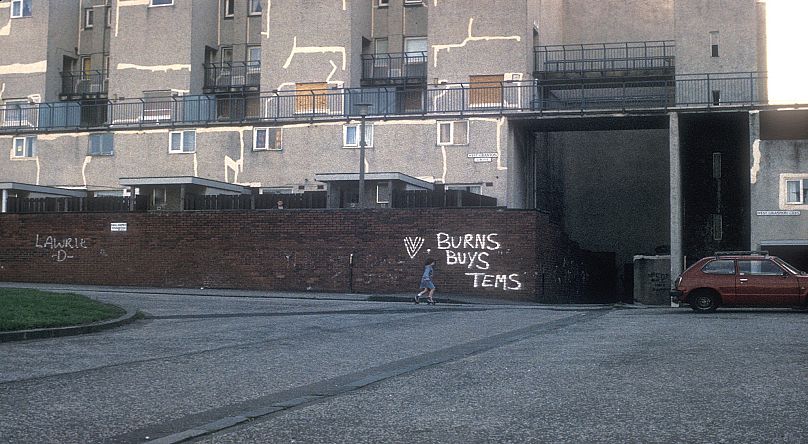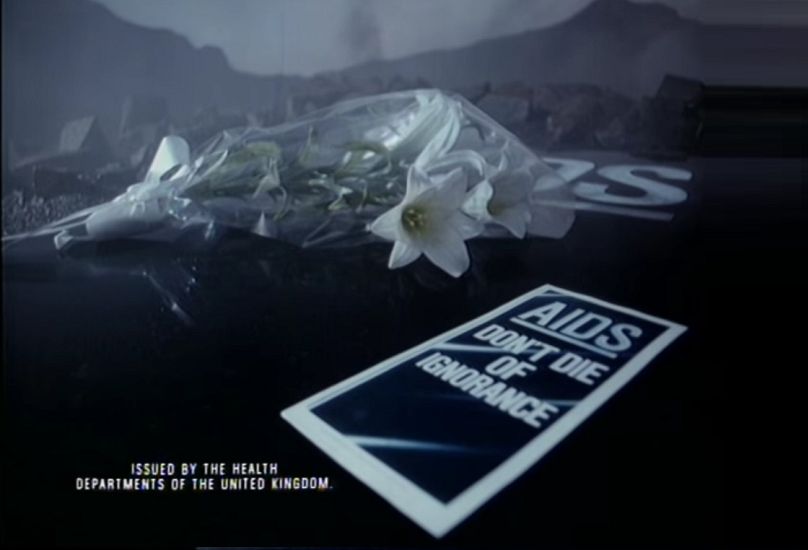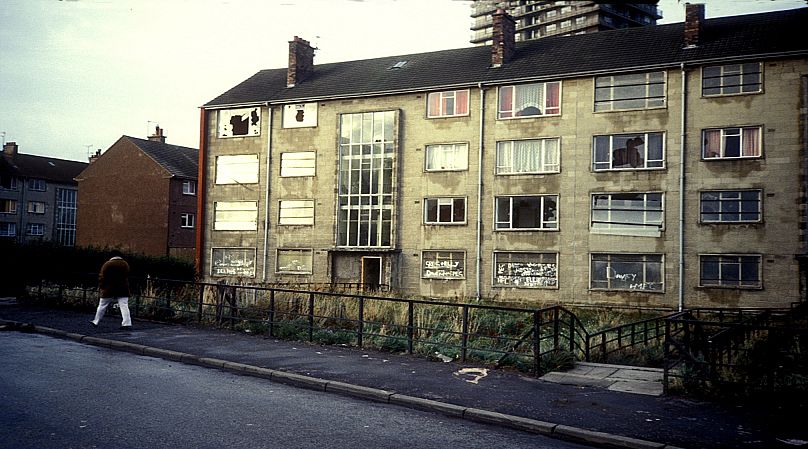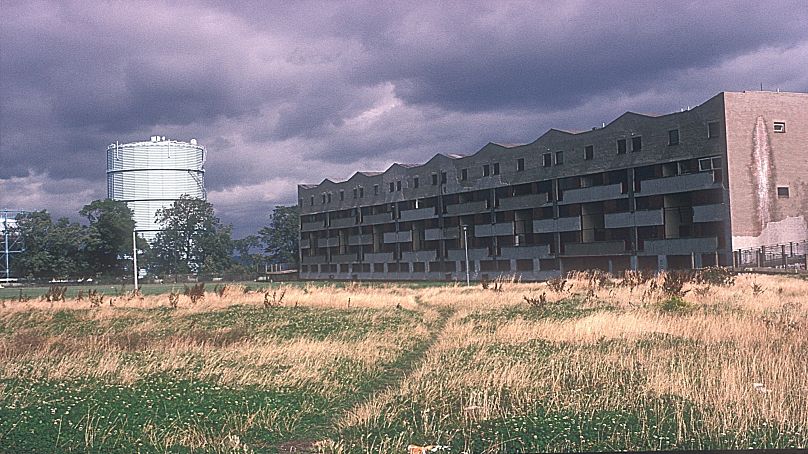World Aids Day | How did Edinburgh become the 'Aids capital of Europe' in the 1980s?
How did the Scottish capital become known as the Aids capital of Europe in the 1980s? The answer lies somewhere between Tory austerity, the 1979 Islamic Revolution and pioneering research.
In the early 1980s, a new disease – as bewildering as it was lethal – began to ravage communities around the world. So how did Edinburgh become known as the Aids capital of Europe? The answer lies somewhere between Tory austerity, the 1979 Islamic Revolution and pioneering research.
Forty years ago, the Scottish capital was in the grip of the Conservative government’s cutbacks and the social problems resulting from rising unemployment and poverty – among them a notable increase in drug abuse. The city police force’s response was to crack down on injecting equipment, a decision that was to prove catastrophic as it prompted drug users into sharing needles.
In Muirhouse, a deprived area in Edinburgh’s northwest, there was a 30 per cent cut in social services in 1980 alone. Dr Roy Robertson was at that time a family doctor in the community’s medical practice, as he is today – in addition to now being a professor of addiction medicine at the University of Edinburgh, as well as the Queen’s physician in Scotland.
“My job was general practice, just dealing with what came through the door. And all of a sudden what came through the door were young people with injection site problems – hepatitis, jaundice. People were dying of overdoses, my patients were being found dead in a stairwell or on the street or in their flats,” he recalls.
“The problem presented itself really quite dramatically to our practice in 1980, '81, '82. We got a small research grant and employed a researcher just to start gathering data and one of the things that we looked at was blood-borne viruses.”
It was not, however, HIV that Dr Robertson and his colleagues were looking for, but hepatitis B. The spectre of this virus had hung over Edinburgh since an outbreak at two of the city’s renal dialysis units in the early 1970s had killed several patients, a doctor and a technician. Dialysis was a new procedure and controls over the handling of blood were nothing akin to today’s procedures.
“When I was a medical student, and I graduated in 1975, everyone was terrified of hepatitis B, it was seen as a lethal disease. And it’s hard to imagine now, but at that time blood was not treated as infectious. You would take a blood sample and you’d get blood all over your hands and squish it into a tube and the tube would be covered in blood and the form you sent it to the lab with would be blood-stained.
“Then during 1981, '82, '83, we had an outbreak of hepatitis B among our drug users. So we started gathering information and doing tests and we published a couple of papers on the epidemic of hepatitis B in our drug users.
“And the public health people were interested, but it wasn’t really a big emergency because it was drug users. People said well, what do you expect? They’re injecting and sharing needles, they’re bound to get something. They were not a priority and not seen as a risk to the general population.”
Then in 1985, the first test for HIV became available. Dr Robertson and his colleagues went back to the blood samples from the group of drug users they had tested for hepatitis B and applied the new test to them.
“We found to our horror that 60 per cent of them tested positive for HIV infection.”
And thus the link between intravenous drug use and HIV was established – and with it a figure for those infected with HIV in Edinburgh. And when Dr Roberston’s research on this was published, the first of its kind, the city emerged effectively by default as the ‘Aids capital of Europe’. By virtue of being the first to become aware of its problem with HIV infection, Edinburgh was labelled the place with the greatest such problem, while elsewhere the issue lay in wait, obscured by ignorance.
Dr Robertson does not lament the label, calling it “useful shorthand,” but says: “It is a bit unfortunate, because clearly there was HIV introduced in many parts of Europe at around the same time. The reason we got that tag was that we had done a bit of research and we had been gathering data prior to the introduction of HIV and so we were in a good position to identify it as a problem.”
However, Murray Cheek of HIV charity Waverley Care – established in 1989 to build the UK’s first purpose-built Aids hospice in Edinburgh, in response to the growing HIV epidemic in the city – feels that the Scottish capital’s label as Europe’s Aids capital added to the stigma of the disease.
“The situation in Edinburgh was exceptional, but the term ‘Aids capital’ was highly sensational,” he says.
“The label was a product of the fear and stigma that surrounded HIV in the 1980s, along with things like the infamous ‘tombstone’ public health campaigns. The impact of these factors are still influencing people’s perceptions of HIV today. Despite the fact that treatment has helped turn HIV into a manageable long-term condition we still come across people who believe it is a death sentence.
“For people living with HIV, this stigma can have a damaging impact on their mental health, and can leave them feeling isolated in their communities. Meanwhile, the stigma puts people off accessing testing because they are worried about a positive diagnosis.”
Dr Robertson agrees the stigma had a tangible impact, as the medical profession battled towards better understanding of the illness that would emerge as Aids, and its precursor virus HIV. He says: “There were reports of something called GRID [gay-related immune deficiency] coming from the United States and a few cases in the UK. But no understanding of it being a virus at this time.
“There was speculation that it was caused by poppers [amyl nitrate, a drug popular on the gay scene], or immune system overload due to people having 1,000 sexual partners a year. Until 1984, '85 it was very unclear what was going on, because it was in marginalised groups. Gay populations were still seen to be outliers, a closed population that didn’t interact with the rest of society.
“Drug users were seen as even worse, just a bunch of criminals inhabiting shady areas, portrayed as hopeless cases. It was very difficult to represent them because you were stigmatised by association – communities and families and even our medical practice.
"There was a lot of hostility towards the gay community and drug users, and of course that only got worse with HIV. Not only were they now a ‘bad’ group of people, they were a ‘dangerous’ group of people. One councillor in Edinburgh suggested we should put them all on an island in the Forth.”
Dr Robertson’s early publishing of his research to an extent gave Edinburgh a label that could have been surpassed by other cities had the same research been carried out elsewhere at the time, and he describes his study as being intended to demonstrate that every city should be testing its at-risk populations.
However, once this began to happen, the figures in Edinburgh remained comparably significantly higher than those in other cities. Once drug users were tested for HIV in Amsterdam, the infection rate was 25 per cent in comparison to Edinburgh’s 60 per cent. The Dutch city had a drug problem on a huge scale, but it had taken the initiative to supply users with needles and syringes and to educate them on the risks of sharing them.
Dr Robertson recalls a headline published after the World Aids Conference of 1985, at which he had presented his research, saying there could be 100,000 cases worldwide. “Actually we know now there were several million in Africa and probably half a million in America,” he says.
“We met with the director of social work for Soweto, one of South Africa's biggest townships, who said he had come to study Edinburgh because we had this massive HIV problem and we asked, over lunch, what about South Africa? Have you not got a problem there? And he said no.
“And we asked how many people have you tested? And he said we haven’t tested anyone, because it’s not there. Probably there were a million people infected in South Africa by that time. That was the enormity of the ignorance of the time.”
Scotland’s largest city, Glasgow, less than 50 miles away, at the time had a larger number of drug users, but in the absence of a similar police crackdown on equipment and the resulting lack of needle sharing, it found itself with far fewer cases of HIV.
Until the dawn of the 1980s, Edinburgh’s population of injecting drug users had been far lower, and of a very different demographic to the one that began to emerge.
Dr Robertson recalls: “In 1973 there was a paper published about the first 100 drug users in Edinburgh. Right up until 1980 the reality in Edinburgh was that there was probably only a few hundred injecting drug users and it was regarded as a small problem peripheral to mainstream medicine and not a public health risk.
“That all changed in 1980. Throughout western Europe there was a flood of heroin that came from Iran and Afghanistan, the countries where the stuff is grown. The Islamic Revolution happened (in Iran) in 1979 and the Russians had invaded Afghanistan, drug trafficking routes linked up and all of a sudden western Europe was flooded with cheap heroin which was injectable, and cities like Edinburgh suddenly had a supply of heroin which just hadn’t been there before.
“And not only that, it was suddenly in communities where it wasn’t familiar. The previous iteration of drug users were not the inner city unemployed youth coming out of schools, with little prospects of jobs. There was a drug culture from the 60s onwards and heroin had been part of that alternative lifestyle. Heroin users had been more of a rebel group, if you like, it was a counterculture thing.
“But here we were dealing with something quite different. What we were seeing in the clinics were 17-year-olds who were suddenly injecting heroin. And these were people living in poor communities in marginalised circumstances, so it was quite a different phenomenon and there was no preparation for it. Then HIV popped in and all of a sudden we had a group that, quite honestly, nobody really cared about, who suddenly represented one of the biggest public health risks of the century.”
When it came to telling the 60 per cent of his original cohort of drug users who had tested positive for HIV that they now had a disease they did not know they were being tested for, did not know existed, Dr Robertson and his colleagues were almost equally in the dark when it came to their prognosis.
“Our patients weren’t aware that we were testing them for HIV. And by today’s standards that would be regarded as inappropriate, to test samples without explicit consent,” he says.
“We had no prior warning that we were going to be faced with this. We didn’t know the full impact of it. I spoke to colleagues in infectious diseases and asked so, what will happen to these people? What am I to tell them?”
The reply was that HIV was an immune system infection much like hepatitis B, and that, similarly to that virus, perhaps 10-15 per cent of patients would become acutely unwell and progress to having a prolonged illness, but the remainder would suffer a mild illness and then fully recover.
“We were completely wrong,” says Dr Robertson. “We know now that anybody who has an HIV infection if it’s untreated will go on to develop advanced disease and eventually die. But back then we were just telling people we need to keep an eye on this and it may or may not get worse. And people would go away and say well, that sounds bad but it doesn’t sound terrible and actually my main problem is my drug use problem or my housing problem or that I’m in court next week.”
Most of the original at-risk group identified and tested by Dr Robertson in the 1980s died before effective treatment for HIV became available in 1996.
Murray Cheek credits the 2017 introduction of PrEP – the daily pill that can prevent HIV transmission – free to at-risk groups on the NHS in Scotland, as well as continued promotion of condom use, for the very different picture in Edinburgh today. “As a result of these and other interventions, new HIV diagnoses are gradually falling over time and new Aids diagnoses are incredibly rare,” he says.
Dr Robertson has not seen a new case of HIV infection at his medical practice in the last 10-15 years. Infection rates have fallen so low that he now cites a new danger: complacency. “Now the drug-using population has a worryingly low concern about HIV infection because it’s a historic sort of thing for them."
Meanwhile, a new label has emerged, for the whole country this time rather than just its capital: Scotland has the highest number of drug deaths in Europe.
Dr Robertson sees one clear parallel between the circumstances under which these two labels were acquired, four decades apart.
“The early 1980s was a bad political time. It was a time of a Conservative government that was, frankly, quite hostile towards problems like this and had little interest or little involvement. There were cutbacks, very similar to today, it was an era of austerity.
“There are publications that link very closely the drug deaths problem to austerity and a similar government approach towards drugs now and then. And quite honestly, it feels very similar to how it did in 1979.”














